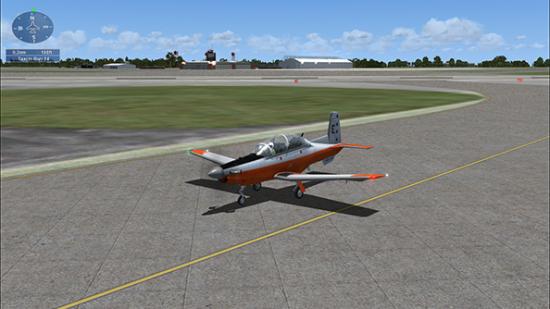For the past couple of weeks I’ve been back at school. Not the A-Level Maths and English, tribal warfare in the lunchtime cafeteria, head flushed down the school toilets, setting fire to the chemistry lab in a fit of teenage angst sort of school. Flight school. Combat flight school. Top Gun-style combat flight school. Yeeaaahhh, baby! Highway to the danger zone, you being my wingman, painstaking memorisation of pre-flight check-lists and VOR radial codes for a nondescript area of Florida – actually mostly just those last ones.
Want more Flight Sim X? Here are the best Flight Sim X add ons.
That’s what’s at the heart of Saitek Combat Pilot, you see. Realism. Which is no surprise given that we’re not talking about some lightweight arcade-style, infinite ammo, playable on a gamepad affair. Saitek uses as a base the Microsoft Flight Sim X engine, with a structured career manager and working combat mechanics bolted to the front of it. The premise is a collection of multiplayer servers, players working together in squadrons, aerial duels filling the skies, military careers being forged, aviation legends being born. But first you have to go to school.
Before you’re allowed anywhere near the good stuff, you first have to prove to Saitek that you know how to even get in the cockpit of a T-6 training jet without banging your head on the canopy. Once logged in, you’re faced with a series of ‘simulated’ (i.e. no penalties if you crash) check-rides, taking you through everything from basic taxiing procedures, through authentic VFR and IFR navigation techniques, all the way to formation flying and a complete solo ride encapsulating it all.
Master them in simulation mode and you can try them out for ‘real’ – albeit still within the simulation’s simulation (at this point your brain start to go all Inception and nothing/everything seems real any more). This is the means by which you earn your stripes and qualify. Naturally, you can’t take the more advanced qualification flights until you’ve both passed the earlier ones and racked up a sufficient number of hours in ‘real’ flight. Yep, you don’t just need to pass the exams, you also need to build up flight hours to move on – all the while sticking to the rigid procedures being taught throughout lest you be docked precious career points (crash in a non-simulated environment and you get a big, red -500 next to your name, marking you out as a liability to your fellow pilots).
Get through that little lot though, racking up nearly ten-fifteen hours of overall flight time, and you finally graduate… to the Advanced Training School. Yes, you’re not done yet. Having mastered the basics, now you have to rack up another 25-30 hours of flight time, this time in a more powerful jet trainer (either the T-45 or T-38 depending on the career path you choose).
Now that all sounds like a lot, but truth be told, experienced Flight Sim pilots shouldn’t have too much difficulty with it all, as long as you stick to procedure throughout. This is where Combat Pilot scores big with me. Because the missions have built to exacting standards, the threat of failing a qualification flight is always there, forcing you to take it all terribly seriously, to not dick about in the air and try to find short-cuts. Plus, you actually feel yourself getting better at flying the more you go through it. Real-world flying is all about discipline and routine, and Saitek has nailed that really well.
It also continually dangles the carrot of reward in front of you. The fact that the training is so extensive, and all the while you know there’s a fabled land of multiplayer combat waiting for you at the end of it, provides a massive incentive to stick with it, even when the big, orange ‘FAIL’ screen appears because you accidentally flew an entire mission with the undercarriage down or something.
What could use serious improvement is the new player experience prior to flights. In-sim you’re guided pretty well through the lessons (although I’d recommend a pencil, paper and liberal use of the pause button to make notes). But it’s rather let down by a clunky, messy front end that could do a much greater job of guiding inexperienced players through the, frankly, complicated world of flight it presents.
It’s bearable though, (hopefully future game patching/updates will address it) and doesn’t take too much away from the fact that Combat Pilot is a novel use of the aging FSX engine, one that takes the realism the sim has always provided and finally marries it to a game structure that provides incentive and reason for you to actually be there.
As I write this, I’m almost through with the qualification flights and will soon be moving on to the live-fire environment. Hopefully my appalling record during training when it comes to basic things like not crashing/getting hopelessly lost/forgetting to raise my wheels after take-off won’t be held against me. I’ll bring you a full report form those aerial front-lines in due course.
